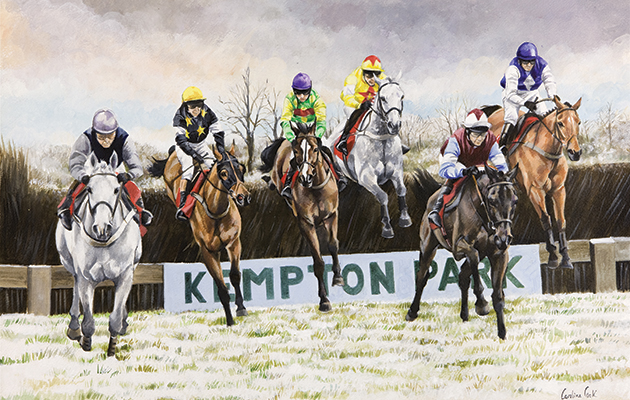With brush in hand, Caroline Cook explains to Janet Menzies how her animal paintings have adapted both to crisis and public appeal
Caroline Cook explains to Janet Menzies how her art has adapted through multiple crises, and how it is commissioned directly by her public audience via social media.
For more sporting artists, Oliver Akers Douglas captures the sporting scene just before it springs to life. And Michelle Pearson Cooper is bringing the same respect we have for big cats to domestic dog portraiture.
CAROLINE COOK
There are lots of reasons to like the work of Caroline Cook. She captures the world of horse racing with all the authenticity of one who has been involved in it for years. Her animals, whether horses and dogs or wildlife such as stags and foxes, are depicted with accuracy and sympathy. Her painting has a breadth of range from realistic to impressionist. But, for me, the best thing about her work is that it is work – a creative product made from memories, images and ideas.
Cook never stops painting. Even as we are chatting, she is busy at her easel: “You will have to excuse me, I am finishing a commission to go to New Zealand to the Te Akau racing stud. They had five Group One winners in 2020, so I am making a group portrait of the horses. I am painting the final part now – their whiskers.”
Cook’s work never stopped last year, and she even found time to paint the Injured Jockeys Fund 2020 Christmas card, Snowy Beach, showing trainer Christian Williams’ string out exercising on the beach near his yard at Ogmore-by-the-Sea in Wales.
Cook particularly enjoyed this work: “The ones of the strings out training are my favourites. I have a series of these, which are sometimes quite impressionistic. With Homeward Bound, I saw a picture on Jamie Osborne’s Twitter feed where his string was coming back off the gallops and that inspired me to go and paint it. These studies are all actual places, which I think racing people will recognise. I love being able to choose the scenes and create the composition. I try not to take in too much commissioned work because it can be quite restrictive – you have to get it exactly right for what the client wants. But I am commercially minded. I worked for a big greetings card company and learnt a lot about marketing. It is quite an education when you are under such pressure to bring out so many images. Even now, I don’t often paint something ‘just because’ but Homeward Bound was one for me.”

A near miss.
These paintings really deserve to be in a genre of their own – the horsescape – where the presence of the horses defines the distinctive landscapes of the Lambourn Downs or Newmarket Heath. Cook’s intuitive understanding of racing runs through her work and she knows how important racing is to her audience. “One of my best-known works is called The Kings of Kempton, depicting some of the most famous winners of the King George VI Chase. The horses that win these big races are what I think of as the people’s horses. It is the races the general public are watching on telly on a Saturday or on Boxing Day that grip their imagination. Even now, I still sell a lot of Desert Orchid. These horses have huge fan bases, it never fails to surprise me how big a fan base they have – Cue Card from a couple of years ago is still loved.”
She explains: “When I am beginning new work I run a poll and ask people which should be the next subject and people vote for it. I start a picture and put it on Facebook and show the early studies and people get interested in how it works. People often ask if something is for sale – most of my noncommissioned work gets sold straight off social media.”
So Cook is really commissioned directly by her public audience, a process that would be familiar to Charles Dickens and Henry Fielding, who sold their work through subscription and serialisation. At the same time, it’s also a very modern approach, which came about from a national crisis 20 years ago. “To begin with we had a mobile gallery, which we took to Cheltenham and Badminton and Burghley. It is nice to sit there and paint and talk to people – what I do now is an extension of people joining in with you. You get a feel for what people are liking, and you never quite know where you are going to end up. But the foot-and-mouth crisis in 2001 meant we lost our outlets, so I got a recovery grant, but you had to have a business plan to diversify and that completely changed how I did things to going online and exhibiting. Then the next thing was the financial crash in 2008, which destroyed my customer base, so we had to change again and that is when we started with social media. Now, with COVID-19, there is yet another crisis, but for me nothing has changed.”
Already adapted to a 21st-century way of doing things, Cook explains: “I have just taken the opportunity to get through a lot of work.” An artist makes her own work, and that’s a resilience we can all value.
Engage with Caroline Cook via her website: carolinecook.net or call 01823 667057
Facebook: Caroline Cook Artist
Twitter: @horseart1





